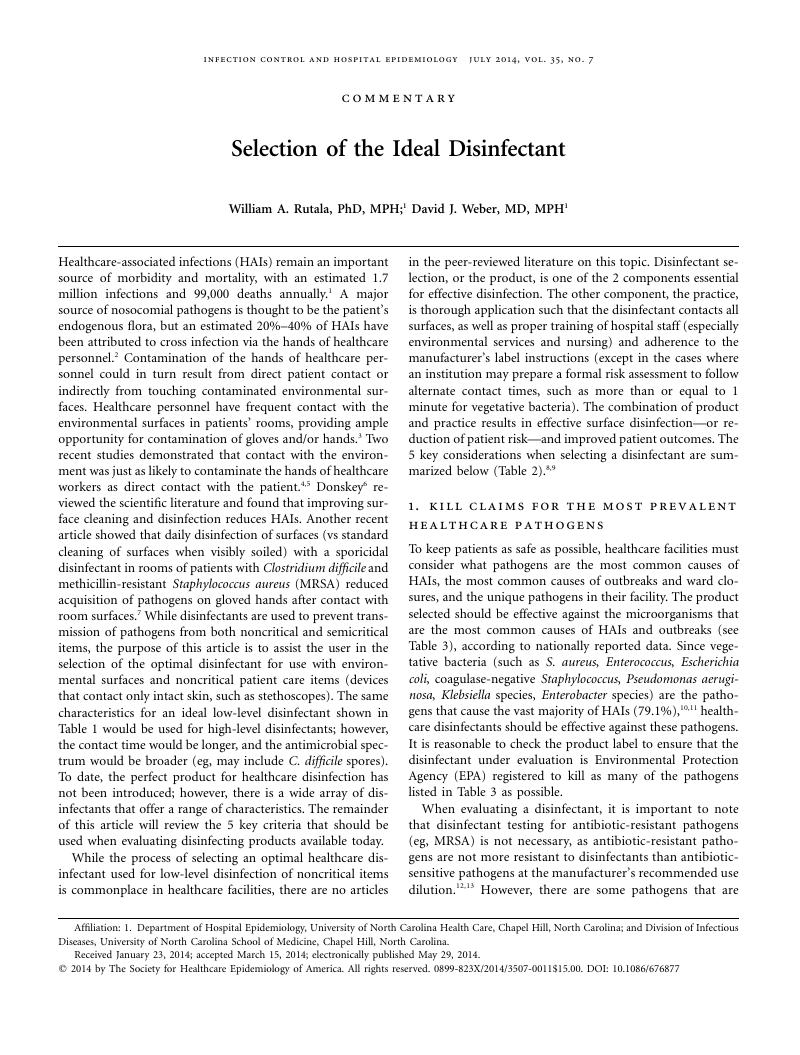Crossref Citations
This article has been cited by the following publications. This list is generated based on data provided by Crossref.
Traverse, Michelle
and
Aceto, Helen
2015.
Environmental Cleaning and Disinfection.
Veterinary Clinics of North America: Small Animal Practice,
Vol. 45,
Issue. 2,
p.
299.
Carling, Philip
and
McCoy, Bobbi J.
2015.
New insights optimize OR environmental hygiene.
OR Nurse,
Vol. 9,
Issue. 4,
p.
16.
Quinn, Margaret M.
Henneberger, Paul K.
Braun, Barbara
Delclos, George L.
Fagan, Kathleen
Huang, Vanthida
Knaack, Jennifer L.S.
Kusek, Linda
Lee, Soo-Jeong
Le Moual, Nicole
Maher, Kathryn A.E.
McCrone, Susan H.
Mitchell, Amber Hogan
Pechter, Elise
Rosenman, Kenneth
Sehulster, Lynne
Stephens, Alicia C.
Wilburn, Susan
and
Zock, Jan-Paul
2015.
Cleaning and disinfecting environmental surfaces in health care: Toward an integrated framework for infection and occupational illness prevention.
American Journal of Infection Control,
Vol. 43,
Issue. 5,
p.
424.
Rutala, William A.
and
Weber, David J.
2016.
Disinfection and Sterilization in Health Care Facilities.
Infectious Disease Clinics of North America,
Vol. 30,
Issue. 3,
p.
609.
Rutala, William A.
and
Weber, David J.
2016.
Monitoring and improving the effectiveness of surface cleaning and disinfection.
American Journal of Infection Control,
Vol. 44,
Issue. 5,
p.
e69.
Rutala, William A.
and
Weber, David J.
2016.
Disinfection, sterilization, and antisepsis: An overview.
American Journal of Infection Control,
Vol. 44,
Issue. 5,
p.
e1.
Carling, Philip C.
2016.
Optimizing Health Care Environmental Hygiene.
Infectious Disease Clinics of North America,
Vol. 30,
Issue. 3,
p.
639.
Kanamori, Hajime
Rutala, William A
and
Weber, David J
2017.
The Role of Patient Care Items as a Fomite in Healthcare-Associated Outbreaks and Infection Prevention.
Clinical Infectious Diseases,
Vol. 65,
Issue. 8,
p.
1412.
Cahill, Orla J.
Claro, Tânia
Cafolla, Attilio A.
Stevens, Niall T.
Daniels, Stephen
and
Humphreys, Hilary
2017.
Decontamination of Hospital Surfaces With Multijet Cold Plasma: A Method to Enhance Infection Prevention and Control?.
Infection Control & Hospital Epidemiology,
Vol. 38,
Issue. 10,
p.
1182.
Saeb, Aya
Mody, Lona
and
Gibson, Kristen
2017.
How are nursing homes cleaned? Results of a survey of 6 nursing homes in Southeast Michigan.
American Journal of Infection Control,
Vol. 45,
Issue. 11,
p.
e119.
Boyce, John M.
Guercia, Kerri A.
Sullivan, Linda
Havill, Nancy L.
Fekieta, Renee
Kozakiewicz, Janet
and
Goffman, David
2017.
Prospective cluster controlled crossover trial to compare the impact of an improved hydrogen peroxide disinfectant and a quaternary ammonium-based disinfectant on surface contamination and health care outcomes.
American Journal of Infection Control,
Vol. 45,
Issue. 9,
p.
1006.
Barenghi, Livia
Barenghi, Alberto
and
Di Blasio, Alberto
2017.
Implementation of Recent Infection Prevention Procedures Published by Centers for Disease Control and Prevention: Difficulties and Problems in Orthodontic Offices.
Iranian Journal of Orthodontics,
Vol. In Press,
Issue. In Press,
Alhmidi, Heba
Koganti, Sreelatha
Cadnum, Jennifer L.
Rai, Herleen
Jencson, Annette L.
and
Donskey, Curtis J.
2017.
Evaluation of a Novel Alcohol-Based Surface Disinfectant for Disinfection of Hard and Soft Surfaces in Healthcare Facilities.
Open Forum Infectious Diseases,
Vol. 4,
Issue. 2,
Rutala, William A.
and
Weber, David J.
2018.
Surface Disinfection: Treatment Time (Wipes and Sprays) Versus Contact Time (Liquids).
Infection Control & Hospital Epidemiology,
Vol. 39,
Issue. 3,
p.
329.
Boyce, John M.
2018.
Alcohols as Surface Disinfectants in Healthcare Settings.
Infection Control & Hospital Epidemiology,
Vol. 39,
Issue. 3,
p.
323.
Lin, W.
Yi, J.
Zhang, Y.
Deng, Z.
Chen, Q.
and
Niu, B.
2018.
Effects of glutaraldehyde–didecyldimethylammonium bromide combined disinfectant on the cell surface of
Staphylococcus aureus
.
Journal of Applied Microbiology,
Vol. 124,
Issue. 5,
p.
1060.
Susan, Muthoni Maina
Andrew, K. Nyerere
and
Caroline, Wangari Ngugi
2018.
Isolation of bacterial diversity present in medical waste and health care settings in hospitals in Kenya.
African Journal of Microbiology Research,
Vol. 12,
Issue. 26,
p.
606.
Pepose, Jay S.
Ahuja, Arjun
Liu, Wenlei
Narvekar, Abhijit
and
Haque, Reza
2018.
Randomized, Controlled, Phase 2 Trial of Povidone-Iodine/Dexamethasone Ophthalmic Suspension for Treatment of Adenoviral Conjunctivitis.
American Journal of Ophthalmology,
Vol. 194,
Issue. ,
p.
7.
West, Alyssa M
Nkemngong, Carine A
Voorn, Maxwell G
Wu, Tongyu
Li, Xiaobao
Teska, Peter J
and
Oliver, Haley F
2018.
Surface area wiped, product type, and target strain impact bactericidal efficacy of ready-to-use disinfectant Towelettes.
Antimicrobial Resistance & Infection Control,
Vol. 7,
Issue. 1,
Kang, J.
Tyan, K.S.
Jin, K.
and
Kyle, A.M.
2018.
Field testing of a novel colour indicator added to chlorine solutions used for decontamination of surfaces in Ebola treatment units.
Journal of Hospital Infection,
Vol. 99,
Issue. 2,
p.
188.



